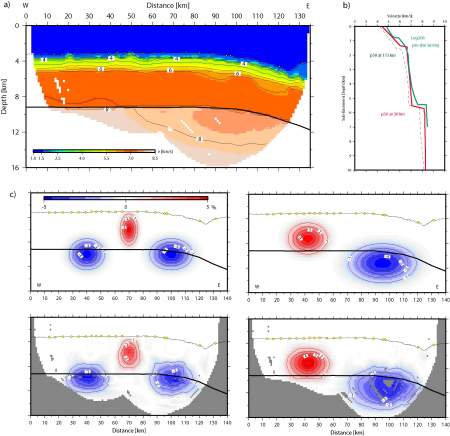 Web Content Anzeige Web Content Anzeige
Bending-related faulting and mantle serpentinization / hydration at deep sea trenchesGrowing observational evidence suggests that the incoming oceanic lithosphere at subduction zones is modified in the so called outer rise - trench area. The outer rise is a consequence of the flexure of the subducting lithosphere, producing a prominent bathymetric bulge seaward of the trench axis. Seismic reflection imaging of the incoming oceanic lithosphere detected faults cutting through the entire crust into the upper most mantle off Middle America and Central Chile that may create pathways for seawater to penetrate to mantle depth. Seismic velocities are the best indicator for studying hydration of the lithosphere at mantle depth. With increasing degree of serpentinization seismic compressional wave velocity is reduced from ~8.0-8.2 km/s for pristine peridotite to ~4.5 km/s at 100% transformation of peridotite to serpentinite. Evidence for mantle rock alteration using seismic velocities derived rom seismic refraction and wide-angle data has previously been found at abandoned spreading ridges and interpreted in terms of hydration and hence serpentinization. Offshore Nicaragua we collected within SFB574 data from a seismic pilot experiment to study mantle velocity where multi-channel seismic data imaged faults that cut ~15 km into the mantle. Indeed, seismic velocities are with 7.6-7.8 km/s much lower than expected for "normal" oceanic crust, indicating plate hydration prior to subduction. This results have been publihed by Grevemeyer et al. (Passive and active seismological study of bending-related faulting and mantle serpentinization at the Middle America trench; Earth Planet. Sci. Lett, 258, 528-542, 2007).
Fig. A5-4: Seismic velocity model from joint travel time inversion of seismic refraction and wide-angle data (a) shows and evolutionary process. Seismic velocities decrease systematically approaching the trench axis (a, b). Resolution tests indicates that observed features are real. These systematic changes in P-wave velocity indicate an evolutionary process in the subducting plate consistent with percolation of seawater through the faulted and fractured lithosphere and serpentinization of mantle peridotites. Seismic resolution tests clearly suggest that reduced velocities in the crust and in the mantle could be resolved with the experimental setup (Fig. A5-4c). If hydration is indeed affecting seismic properties of the mantle, serpentinization reaches 12-17%. Based on the laboratory studies that relate the degree of serpentinization and water content of partially serpentinized peridotites to their seismic P-wave velocities, we estimate that the water stored in this region may range from ~1.5 to 2.5 wt% in the uppermost 3-4 km, where seismic data provide enough resolution. A revised paper has recently been submitted (Ivandic et al., Impact of bending related faulting on the seismic properties of the incoming oceanic plate offshore of Nicaragua, revised for J. Geophys. Res., December, 2007). |
 Events Events
Kieler Wissenschaftler fühlen den 'Puls der Erde' Wie funktioniert die Recyclingmaschine der Erde?Nach elf Jahren endet der Kieler Sonderforschungsbereich 574 zu Subduktionszonen Final colloquium of SFB 574 Teilprojekt ÖffentlichkeitsarbeitMEERESFORSCHUNG FÜR MICH UND DICH |
|
©SFB574 // Wischhofstrasse 1-3 // D-24148 Kiel // T. +49 (0)431 600 1413 // elange [AT] geomar.de






